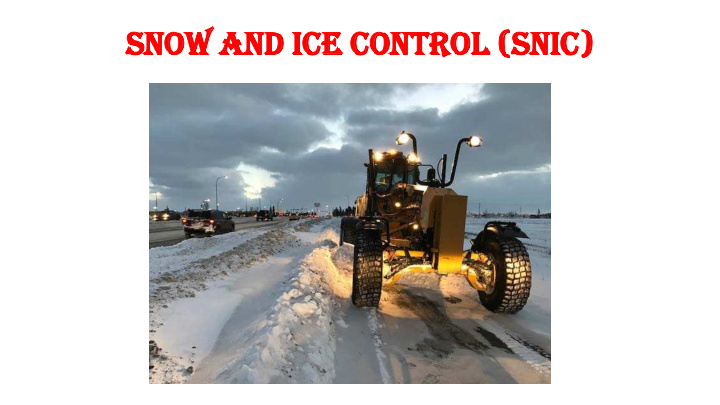



Snow and Ice control (SnIc)
Plow Truck with Sanders Blade Inventory Loader with Blower 2
Parks & Open Space Equipment 3
Sand and Salt Storage SNIC Signs 4
Byla Bylaw Procedu edure re Poli Policy cy 5
6
Snow Storage Facility (Public Works) 7
Contract Snow Haulers – Safety Meeting and Truck Inspection 8
9
City R y Resou ources Winter Road Maintenance • 16 staff divided into 3 shifts providing 2 3 hour/day, 7 day/week coverage • 3 Wheel Loaders • 3 Plow Trucks with Sanders • 2 Road Graders • 2 Skid Steers with attachments • 1 Parking Lot Sander • 3 Loader Mounted Snow Blowers • Various attachments such as an Ice Breaker, Anti-icing unit and 6-Way Plow 10
Contract act R Resou ource ces Winter R r Road oad Mai aintenance ce • Hwy 16A Maintenance Contract – 3 Plow Trucks with Sanders • Residential or Snow Route Snow Removal – 4 Road Graders and 4 Skid Steers • Snow Hauling Roster – Approximately 130 Tandem and End Dump Trucks registered annually to be included in the rotation • Snow Storage Facility Contract – 2 D6 Caterpillars 11
City Resou ources es Winter Sidewalk, Pathway and Transit Stop Maintenance • 14 staff working 10 hour shifts 7 days/week • 2 Compact Tractors with Plows and Sanders • 1 Trackless Municipal Tractor with Plow/Blower/Sander • 1 Skid Steer with attachments • 1 Toolcat Utility Vehicle with attachments • 4 John Deere 1585’s with attachments 12
Roadway Snow and Ice Control Budget • The 2018 operations budget is approximately $2,600,000 and this includes costs for labour, contracted services, rental equipment and materials. Sidewalk & Pathway Snow and Ice Control Budget • Expenses for this service total approximately $600,000 annually. 2018 Inventory Totals • 307 Lane Kilometers of roadway • 66 Linear Kilometers of sidewalks and pathways • 37 Transit stops • 9 City Facilities 13
Snow and Ice Control Policy (CP-1002-17) • The Snow and Ice Control Policy provides the overall direction for the provision of the service. • It is the document that sets the levels of service to be provided within the community. Road Classification and Prioritization • Roadways are classified by type and these types are grouped and ordered in a hierarchy based on their engineered design and function. • Operationally we use the same hierarchy to set servicing priorities so roadways that carry more traffic and have higher speeds are serviced before roads with fewer cars moving at slower speeds. 14
15
16
17
18
Sidewalks and Pathways (Map 1) 19
Sidewalks and Pathways (Map 2) 20
Challenges for Snow and Ice Control Services: The growth of transit means more transit stops to clear. Increased resources will be needed to maintain the current service level as transit expands. Growth of the City means more roads and pathways are added to inventories annually. Service levels that are set by time may need to be adjusted or more resources may be required. Services that use accumulations as a trigger point may take longer to complete than desired or longer than what was previously possible. Ongoing public relations and communications. It is critical to ensure residents (especially new residents) have a good understanding of the service model to ensure a high level of cooperation with program delivery. Continuing compliance issues with respect to parking restrictions. Towing is onerous and does continue to slow the pace of work. Staff turnover impacts the effectiveness and efficiency of program delivery as more time has to be allotted for hiring, onboarding, training and supervision. Higher traffic volumes require a quicker response time following a weather event but more traffic on the roadways also tends to slow production. Increasing occurrence of unpredictable or extreme weather events. Meeting resident expectations. Past program successes can become the new measuring stick irrespective of any of the challenges listed above. 21
Recommend
More recommend